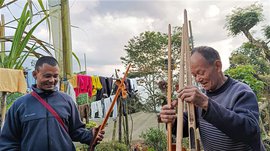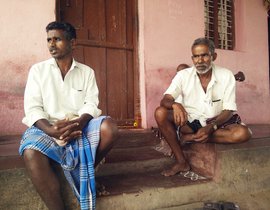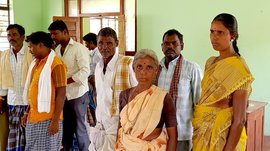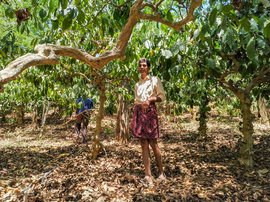“I would remember two-three words from my mother’s singing,” said Hausabai Dighe. The year was 1995 and she was speaking to Hema Rairkar and Guy Poitevin. The social scientists and activists from Pune who initiated the Grindmill Songs Project (GSP) in the late 1980s, had arrived in Bhambarde village of Mulshi taluka with their team to talk to women performers of the grindmill songs.
Hausabai then added, “when I return from labouring in the fields and find there’s no flour, I sit down at the grindmill and sing as I work. Our day feels incomplete without it. The songs flow as I remember the words. These songs will stop only when I die. Until then, I will remember them.” Her words speak for scores of rural women singers who belonged to the communities of farmers, agricultural labourers, fisher folk, potters, and gardeners. Working long hours every day, they were up much before sunrise to tackle the household chores and the work in the fields.
And almost always, the first chore of the day was sitting at the stone mill to crush grain to flour. They sang as they did it. The corner of the kitchen or veranda was their zone of comfort, a private space for them to share their struggles, joys, sorrows and triumphs with each other through the songs.
While doing it, they also shared their views on the world, the life in their village and community, familial relationships, religion and pilgrimages, the oppressions of caste and patriarchy, the work of Babasaheb Ambedkar and much more. In the video, Tarabai Ubhe from Khadakwadi hamlet of Mulshi taluka , Pune, talks about it.
This documentary by PARI also interviews Bernard Bel, the musicologist and technologist who recorded the songs and built the grindmill songs database, Jitendra Maid, the researcher who transcribed the songs in Marathi, and Asha Ogale, who translated the songs from Marathi to English.
The GSP came to PARI in 2016 and we began publishing the songs from March 6, 2017. Read: The grindmill songs: recording a national treasure .
Now seven years later, PARI continues to meet the women singers in their villages and publish their stories and songs. You can view our collection here: The Grindmill Songs Project: all stories so far
The women singers featured in this documentary are only a few from among the 3,302 performers from 1,107 villages of Maharashtra and 11 villages of Karnataka who contributed to this collection of 110,000 jatyavarchya ovya or grindmill songs.
The huge task of transcribing their songs fell to Jitendra Maid and a few others; Rajani Khaladkar entered the song transcriptions in Marathi on to the growing database. Hema Rairkar translated some of the songs. Asha Ogale continues working on the translations along with Maid and around 30,000 songs remain to be done.


Left: Hausabai Dighe from Bhambarde village of Mulshi taluka . Right: Hausabai singing ovis with Kantabai Dighe (centre) and Ashabai Pawar (left) when PARI visited them in December 2023

The women sang the songs when they sat at the stone mill to crush grain to flour and hence the name – jatyavarchya ovya or grindmill songs
This short film is an introduction to the project and includes video footage captured in the 1990s by musicologist and technologist Bernard Bel and the team of researchers and activists accompanying him.
Bel recorded about 4,500 songs on tapes from 1995 to 2003, but the groundwork for the massive project began much earlier. That was in the 1980s when Gee Baba and Hematai – as the singers addressed the founders of this project with respect and affection – had travelled to some of the villages in Pune district. They had set out to work with the women and support them in their struggle to access basic facilities like drinking water, as well as to fight against social evils like dowry and domestic abuse. It was then that these women shared their thoughts and the stories of their lives through the songs. They are a record of the struggles and joys of women in this part of rural India.
GSP’s music and poetry has reached far and wide. In 2021, it was part of the 13th Gwangju Biennale in South Korea. It was also part of the exhibition at the Gropius Bau Museum in Berlin in 2022 and at the London Barbican in 2023. Several articles in the media have featured the project including the Indian Express, Scroll.in, The Hindu BusinessLine , and more.
A doctoral researcher in Nashik is using grindmill songs on Babasaheb Ambedkar for his thesis; A scientist at a US university is referencing couplets in the GSP database and other folk music sources that have nature descriptions that include names of thorny trees like bori (jujube), babhul (acacia), khair (catechu) and others, from the Pune district area. Through the year, many students and scholars reached out to PARI’s collection.
Do watch this massive project that has brought so many people together, and has illuminated the path for researchers, the general public and admirers of folk music and poetry.
This documentary has used footage from archival video 'Unfettered Voices' by Bernard Bel, and clips and photographs from GSP stories published on PARI from 2017 till date
.




